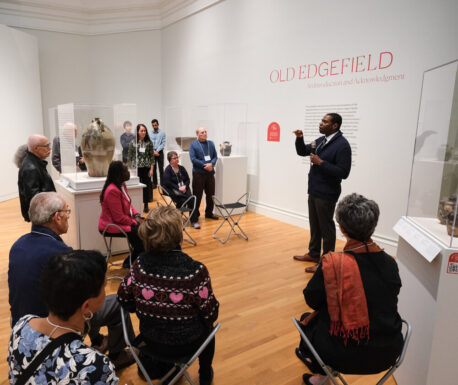Audio Tour – Example
Sample Audio Tour
This is a sample audio tour using UMMA’s new accessible audio player. As the audio plays a transcript can be activated that will highlight the words spoken in real-time.

Hear Me Now — Introduction
[00:00:00.92] [MUSIC PLAYING]
[00:00:04.60] This object was made by force.
[00:00:09.45] I don't think that we have spent enough time thinking about what art is when it's the product of coercion.
[00:00:18.29] We believe that slavery was that for agriculture cotton and tobacco pottery in South Carolina. Really shows a different history.
[00:00:29.76] During the 19th century, hundreds of enslaved people labored in the potteries of old Edgefield district, South Carolina. Around you, are the products of that involuntary labor. The works of Edgefield potters.
[00:00:44.04] It really was quite an industrial operation.
[00:00:47.67] But within that industrial stoneware operation, potters were producing extraordinary works of art.
[00:00:53.61] There is somehow the idea that artistic agency is antithetical to enslavement. But if you look at these objects, you'll see that is not the case.
[00:01:09.84] Welcome to the audio guide for Hear Me Now, The Black Potters of Old Edgefield South Carolina. For this tour, we've invited artists, historians, potters and an archeologist to consider the work of the enslaved potters of Edgefield within the context of a brutal system of repression.
[00:01:29.16] When we don't interrogate enslaved artisans in the same way we interrogate all of our other artisans and craftspeople, we lose a very, very big part of the story. Not just the story then, but the story that we're living now.
[00:01:44.04] Please stay with us for a closer look and to hear how these works testify to the lived experiences, creativity and material knowledge of enslaved peoples. This audio guide is sponsored by Bloomberg Philanthropies.

Storage Jar - Concatination
[00:00:00.000] This jar was made by an enslaved man named Dave.
[00:00:05.040] Vincent Brown, Charles Warren Professor of American History
[00:00:08.490] and Professor of African and African-American Studies
[00:00:11.400] at Harvard University.
[00:00:12.930] He signed his pottery Dave, simply Dave,
[00:00:16.620] and was known as Dave Pottery or Dave the Potter.
[00:00:20.550] He took a surname Drake after emancipation.
[00:00:25.410] The fact that he's literate in a society
[00:00:27.600] where it's illegal for the enslaved to learn how to read,
[00:00:31.110] there's a boldness in making these inscriptions.
[00:00:34.110] He's kind of marking out a status for himself
[00:00:37.050] as someone who can commit a crime by writing
[00:00:40.950] and not be punished for it.
[00:00:44.160] On this jar, Dave has written a single word, concatenation,
[00:00:48.810] and the date.
[00:00:50.460] This is the earliest verse that we know of in Dave's hand.
[00:00:54.270] Concatenation, a series of interconnected things
[00:00:57.540] or events.
[00:00:58.560] The date, I think, is important there
[00:01:00.360] because it's June 12 1834.
[00:01:03.450] Slavery was abolished in the British empire on August 1,
[00:01:07.380] 1834.
[00:01:08.700] So emancipation is coming.
[00:01:10.830] It's not coming to the United States
[00:01:12.600] for another three decades.
[00:01:14.320] But I like to think that news was
[00:01:16.830] traveling about the coming of British emancipation
[00:01:19.680] in the Caribbean.
[00:01:20.700] Nat Turner's revolt had occurred just a couple of years
[00:01:23.760] earlier in Virginia.
[00:01:25.140] And that could be bound up in Dave's sense of the coming
[00:01:28.470] of a great change.
[00:01:29.580] Of course, we can't know.
[00:01:31.170] We can only speculate.
[00:01:32.590] But I think that the speculation takes us
[00:01:35.100] into the world of Dave.
[00:01:37.260] Dave's fondness for words with many syllables
[00:01:40.110] like concatenation brought him a certain measure of notoriety.
[00:01:44.280] The first reference to Dave that I think we know of
[00:01:48.720] is in the Edgefield Advertiser where Dave describes
[00:01:52.890] how much he likes buttermilk.
[00:01:54.840] The word he uses to describe buttermilk?
[00:01:57.420] Magnanimous.
[00:01:58.770] Dave is described as that grandiloquent old darky.
[00:02:02.340] He's a local celebrity, but he's a mascot.
[00:02:05.640] I think that often still works out
[00:02:08.550] in advertisements and endorsements
[00:02:11.250] where people who may be stigmatized because they're
[00:02:14.340] from poor communities and often from Black communities
[00:02:17.610] are maybe celebrated for something like athletic skill.
[00:02:20.280] And they wind up being mascots for things like shoes
[00:02:23.880] or for Wheaties.
[00:02:25.560] It also suggests that we need to always
[00:02:28.860] be considering not only the talent, but also
[00:02:32.400] the social predicament of these artisans
[00:02:35.220] that we're looking at here.